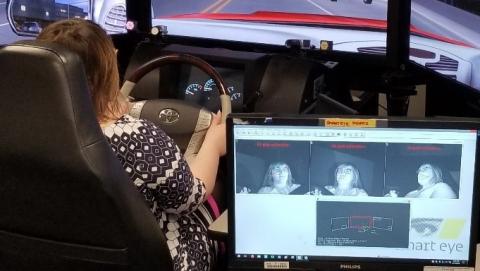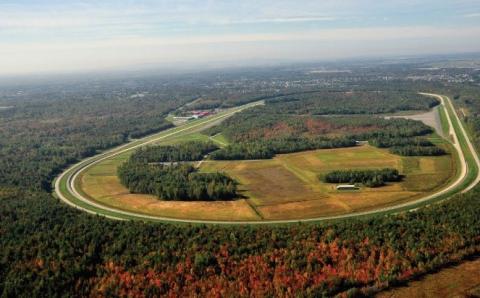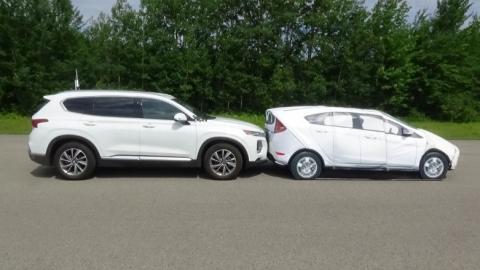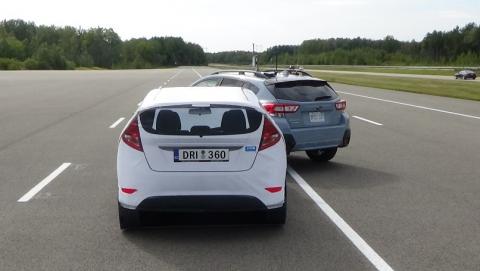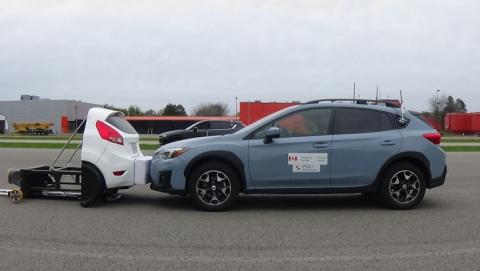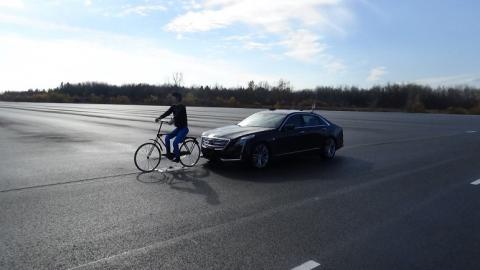Learn why testing connected and automated vehicle technologies is important, and where the latest testing and research is happening in Canada.
On this page
- Why test these technologies in Canada?
- Connected and automated vehicle research at Transport Canada
- Testing connected and automated vehicles at the Motor Vehicle Test Centre
- Search our interactive map of testing and research sites
Why test these technologies in Canada?
Canada is an ideal place to test connected and automated vehicles. We have a highly educated workforce, and strong automotive manufacturing and information technology sectors. We are a world leader in artificial intelligence and have state-of-the-art research and testing facilities.
In addition, because we have four distinct seasons and one of the world’s largest roadway networks, we can test:
- in a wide range of weather conditions
- on diverse road surfaces
- in a vast range of geographic environments
Connected and automated vehicle research at Transport Canada
Transport Canada uses a hands-on approach to investigating human factors and vehicle system safety. We plan and set up our own studies, collect and analyze the data, write the reports, publish and present the results.
We conduct in-house and collaborative research with domestic and international partners to better understand emerging vehicle technologies. We run on-road studies of driver assistance technologies, and also study the human machine interface (HMI) and user interactions with vehicles with partial automation.
Learn more about the levels of automation
We also use an in-house driving simulator equipped with driver assistance systems to safely study driver interactions with those technologies, and research driver behaviour in a safe and controlled environment. Using the simulator allows us to develop and design specific driving scenarios and events, like road layout, traffic and weather.
In addition to using the simulator, we collect data using eye tracking software. Visual behaviour is a key part of safe driving. The eye tracker allows us to carefully measure where drivers look while driving. The use of eye tracking is a key part of driver assistance technology research for understanding human interaction and supporting safety with new automated driving systems.
With the information from our research, we provide evidence to policy and regulatory bodies to help them develop guidelines, standards and regulations.
Transport Canada also undertakes public opinion research to better understand Canadians’ attitudes, awareness and confidence in emerging vehicle technologies, and how they learn about them. A 2019 study gauged views from over 3,000 Canadians using an online survey. Another study, undertaken in 2020, included a survey of 2,500 Canadians followed by an online discussion with a smaller group. The final reports from the 2019 study and 2020 study are available on the Library and Archives Canada website.
Testing connected and automated vehicles at the Motor Vehicle Test Centre
The Motor Vehicle Test Centre in Blainville, Quebec is a world-class testing ground. The Centre is owned by the Government of Canada and managed by PMG Technologies. It has resources to test vehicles and equipment, including connected and automated technologies.
This centre:
- Assesses how well motor vehicles, child seats and booster seats comply with current safety regulations and standards
- Finds gaps in existing regulations, and provides scientific basis for new regulations and standards that meet the changing safety needs of Canadians
- Does ad-hoc testing to address suspected safety issues
The centre has 545 hectares of land, 6 buildings which include laboratory facilities, and 25 kilometres of test tracks.
We are doing a number of tests at the Motor Vehicle Test Centre to assess the effectiveness of driver assistance technologies currently available on the market. Driver assistance technologies are the building blocks to fully connected and automated vehicles. These technologies do things like braking automatically in emergencies, or alerting drivers when a car leaves its assigned lane. Refer to the driver assistance technologies page for more information about these features.
At the Motor Vehicle Test Centre, we use advanced equipment, test dummies and deformable cars to conduct thorough and damage-free testing that helps us assess the safety of connected and automated vehicle technologies.
For example, we test lane support systems to evaluate how they could improve road safety.
To evaluate automatic emergency braking systems, we recreate scenarios where vehicles need to avoid a collision with another vehicle.
Our tests also look at how well these systems detect and avoid collisions with vulnerable road users, like cyclists and pedestrians, in different weather conditions.
Search our interactive map of testing and research sites
Click through the interactive map below to find out more about testing and research of connected and automated vehicle technologies happening here in Canada.
This list is not intended to include every initiative across the country. If you or your organization is testing, demonstrating or exhibiting connected and automated vehicle technologies and would like that information displayed in this map, please contact us at:
Telephone: 1-800-333-0371 (toll-free), 613-998-8616 (Ottawa-Gatineau region)
Email: mvs-sa@tc.gc.ca
|
Name of Initiative |
Location |
Type of research |
Description |
Zoom |
|---|---|---|---|---|
|
Sub Zero North |
Thompson, MB |
Research, test facilities and test beds |
Sub Zero North is a testing facility in Thompson, Manitoba that specializes in cold weather and winter testing. The facility tests a wide range of vehicle types, including heavy equipment, cars, and buses and can help with advanced technology testing including existing fiberoptic cable connections. |
|
|
Innovative Vehicle Institute (IVI) |
Saint-Jérôme and Montréal, QC |
Research, test facilities and test beds |
The Innovative Vehicle Institute (IVI) operates out of 2 testing facilities in Jérôme and Montréal, Québec. The Institute was founded in 2015 and helps conduct applied research as well as design and integrate vehicle technologies to promote innovation. IVI specializes in the testing of electric, autonomous, and connected vehicles and is equipped with a variety of technology for testing powertrains, and subsystems of electric, hybrid and fuel-cell powered vehicles. |
|
|
16th Avenue V2I Test Bed |
Calgary, AB |
Research, test facilities and test beds Public road trials, demonstrations and pilot projects |
The City of Calgary has installed connected vehicle equipment at 16 signalized intersections along 16th Avenue North. This number includes one test location and one lab location. On-board equipment was tested and installed in several city emergency vehicles during the spring of 2020. The 16th Avenue implementation will be used as a test bed, allowing the city to carefully test many applications of this technology. |
|
|
Autonomous Vehicle Research and Intelligence Laboratory (AVRIL) |
Waterloo, ON |
Research, test facilities and test beds |
AVRIL is a shared research workspace at the University of Waterloo dedicated to advancing connectivity and autonomous vehicle technology. The facility's research activities include automated driving, connected vehicles (V2X), and advanced driver assistance systems (ADAS). The laboratory hosts the following equipment and facilities:
The facility has 10 test vehicles, including driverless shuttles, autonomous field platforms, passenger vehicles, commercial trucks, and transport trucks. |
|
|
Canada Excellence Research Chair Laureate Program at McMaster Automotive Resource Centre (CERC@MARC) |
Hamilton, ON |
Research, test facilities and test beds |
CERC@MARC is a research program at McMaster University focused on electrification and smart mobility. Areas of research include electric and hybrid vehicles, autonomous vehicles, V2X systems, embedded software and controls, advanced driver assistance systems (ADAS), artificial intelligence and machine learning, and driving simulations. |
|
|
Driving Research in Virtual Environments (DRiVE) Lab |
Guelph, ON |
Research and test facilities |
The University of Guelph's DRiVE lab is looking for ways to reduce collisions by investigating factors that affect crash risk. The facility uses a simulator made up of a complete car body surrounded by viewing screens that provide a 300 wrap-around virtual environment. The simulator also includes a variety of physical feedback systems that provide drivers with the sights, sounds, and some of the sensations of driving. The simulator is used to study the impact of in-vehicle technologies, including partial automation. |
|
|
Navya Montréal Pilot Project - COMPLETED |
Montréal, QC |
Public road trials, demonstrations and pilot projects |
En 2021 et en 2022, une expérimentation de deux minibus autonomes a eu lieu dans l'arrondissement de Rosemont–La Petite-Patrie, à Montréal, où deux navettes du fabricant français NAVYA ont été exploitées par Keolis Canada Innovation, S.E.C. Ce projet, encadré par la Ville de Montréal, a été déployé en deux phases. La première phase d'expérimentation a débuté le 28 octobre 2021 jusqu'au 10 décembre 2021. La deuxième phase a eu lieu du 27 juillet 2022 au 1er septembre 2022. Les navettes ont emprunté un trajet sur une boucle d'environ deux kilomètres sur les rues Saint-Hubert et Saint-André, entre les rues Jean-Talon Est et Beaubien Est. Le service des navettes était gratuit et offert du mercredi au dimanche. Le projet a pris fin le 1er septembre 2022. |
|
|
Marches Golf Course Trial - COMPLETED |
Ottawa, ON |
Trials, demonstrations and pilot projects |
The Marches Golf Course Autonomous Shuttle trial operated for 3 days in August 2019. The trial used 2 Aurrigo shuttles along a paved path with no traffic. During the trial, the vehicle operated at a maximum speed 12km per hour with Transport Canada employees acting as passengers. The vehicle operated at SAE Level 4 autonomy. The trial helped improve our understanding of passenger safety perception, trust, and acceptance when interacting with automated shuttles. |
|
|
Tunney's Pasture Autonomous Shuttle Trial - COMPLETED |
Ottawa, ON |
Public road trials, demonstrations and pilot projects |
The Tunney's Pasture Autonomous Shuttle Trial ran for 10 days in November 2020. The project consisted of 2 EasyMile shuttles operated on public roads with mixed traffic. The shuttle operated at SAE Level 4 autonomy and was open to members of the public. The maximum speed of 15km per hour. The goals of the trial were:
This project was a collaboration between several groups, including Area X.O operated by Invest Ottawa, Transport Canada, the Ontario Ministry of Transportation, the City of Ottawa, EasyMile, and the National Research Council of Canada. The trial helped further understanding of passenger safety perception, trust, and acceptance when interacting with automated shuttles. |
|
|
Alberta Motor Transport Association (AMTA) Cooperative Truck Platooning System (CTPS) Trials - COMPLETED |
Airdrie and Leduc, AB |
Public road trials, demonstrations and pilot projects |
The Cooperative Truck Platooning System trials demonstrated 2 heavy duty vehicles equipped with SAE Level 2 lane centering and adaptive cruise control technologies. The vehicles platooned in a “road train” formation and the trucks traveled at 3, 4, or 5-second intervals. The trials evaluated fuel efficiency, greenhouse gas emissions, traffic interactions, and the driver's experience. The trial was partly funded by Transport Canada and was the first in Canada to demonstrate Level 2 driving automation on public roads. |
|
|
Gatik's Autonomous Delivery Fleet |
Greater Toronto Area, ON |
Public road operations |
In partnership with Loblaws, Gatik delivers goods in light duty vehicles on 5 routes across the Greater Toronto Area (GTA). In 2022, Gatik launched Canada's first driver-out delivery service, moving goods between a Real Canadian Superstore and Loblaw's headquarters in Brampton. |
|
|
Toronto's Rouge Hill Automated Shuttle Trial- COMPLETED |
Scarborough, ON |
Public road trials, demonstrations and pilot projects |
The West Rouge Automated Shuttle Trial was conducted in fall 2021, and was a collaboration between the City of Toronto, Toronto Transit Commission (TTC) and Metrolinx. The trial used the Local Motors Olli 2.0 shuttle, which operated on a 4km route with 7 fixed stops. The goal was to test a low-speed, electric, automated shuttle vehicle that would connect Rouge Hill GO Station to destinations in the West Rouge community in south-east Scarborough. The trial was an opportunity to:
The trial was funded by a contribution from Transport Canada through the Program to Advance Connectivity and Automation in the Transportation System (ACATS), as well as funding from the City of Toronto, TTC and Metrolinx. |
|
|
Montreal's Olympic Park Automated Shuttle Pilot- COMPLETED |
4141 Pierre-de Coubertin Ave., Montréal, QC, H1V 3N7 |
Trials, demonstrations and pilot projects |
Transdev is using Olympic Park in Montreal as a location for a few automated shuttle pilots. The pilots have tested numerous automated shuttles on a pre-programmed route at the Park and surrounding areas. To date, thousands of passengers have been able to experience these shuttles through these pilots. |
|
| Montreal's Olympic Park Automated Shuttle Pilot |
Montréal, QC |
Trials, demonstrations and pilot projects |
Transdev is using Olympic Park in Montreal as a location for a few automated shuttle pilots. The pilots have tested numerous automated shuttles on a pre-programmed route at the Park and surrounding areas. To date, thousands of passengers have been able to experience these shuttles through these pilots. |
|
|
Motor Vehicle Test Centre (MVTC) |
Blainville, QC |
Research, test facilities and test beds |
Transport Canada’s Motor Vehicle Test Centre, which is operated by PMG Technologies, tests vehicles to make sure they follow Canadian safety standards. The centre also does research to help develop new standards. The centre includes:
The centre does regular tests on connected and partially automated vehicles (levels 1 and 2), as well as truck platooning. |
|
|
ENCQOR (Evolution of Networked Services through a Corridor in Quebec and Ontario for Research and Innovation) |
Windsor, ON to Quebec City, QC |
Research, test facilities and test beds |
The Governments of Canada, Ontario, Quebec and five major technology companies partnered to create Canada’s first pre-commercial 5G wireless corridor between Windsor and Quebec City. Small and medium-sized companies, researchers and academics will be able to use the 5G network to develop and test their products. With potential speeds of up to 10 gigabits per second and ultra-low latencies of milliseconds, 5G could be critical to a new generation of products and services, including connected and automated vehicles. |
|
|
General Motors Canada Markham Technical Center |
Markham, ON |
Research, test facilities and test beds |
General Motors' Markham Technical Center focuses on the development of GM automated vehicle technologies:
These are vital areas for the development of connected, automated and shared vehicles and mobility systems. |
|
|
Ford Motor Co. Connectivity and Innovation Centre in Kanata |
Kanata, ON |
Research, test facilities and test beds |
With the help of the Government of Canada and the Government of Ontario, Ford Motor Co. established a research and development centre in Kanata to advance connected and automated vehicle technology. |
|
|
National Research Council Canada Manufacturing and Automotive Innovation Hub research facility |
London, ON |
Research, test facilities and test beds |
This National Research Council of Canada Manufacturing and Automotive Innovation Hub is part of the National Region's Automotive and Surface Transportation Research Centre. The open space helps Canadian car makers use advanced manufacturing approaches, including:
The space will develop new ways to enable digital factories (“Industry 4.0”) that will produce technologies like connected and automated vehicles. |
|
|
NAVYA Candiac Shuttle Pilot - COMPLETED |
Candiac, QC |
Public road trials, demonstrations and pilot projects |
Keolis Canada partnered with the City of Candiac to launch the first long-term demonstration of an automated electric shuttle on public roads in Canada. The shuttle will complement existing public transit services in Candiac. The project began in October 2018. |
|
|
ELA Pilot Project - COMPLETED |
Edmonton, Vancouver and Surrey, BC |
Public road trials, demonstrations and pilot projects |
ELA was the first electric and automated shuttle open to the public in Canada. It can carry up to 12 passengers, and works on existing roadways with no additional equipment or upgrades needed. The pilot project’s goal is to:
Since September 2018, the project team has shown ELA to audiences in several locations in Alberta and British Columbia including:
As of July 2019, over 11,000 passengers have taken trips with ELA. |
|
|
ACTIVE |
Edmonton, AB |
Research, test facilities and test beds |
The three on-road Alberta Co-operative Transportation Infrastructure and Vehicular Environment (ACTIVE) test beds are located on Whitemud Drive, 23 Avenue, and Anthony Henday Drive in Edmonton. Research on these test beds will look at how connected vehicle technology can help:
The ACTIVE-AURORA project is made up of four test beds and two laboratory test environments. ACTIVE is the Edmonton component and AURORA is the Vancouver component. |
|
|
AURORA |
Vancouver, BC |
Research, test facilities and test beds |
This on-road Automotive Test Bed for Reconfigurable and Optimized Radio Access (or "AURORA") will develop, test, demo and commercialize innovations in Vancouver. Its focus is wireless communications for freight security and efficiency. The ACTIVE-AURORA project is made up of four test beds and two laboratory test environments. ACTIVE is the Edmonton component and AURORA is the Vancouver component. |
|
|
Uber Advanced Technologies Group Toronto |
Toronto, ON |
Research, test facilities and test beds |
Uber is conducting a research and development program focused on automated vehicle technologies at its Toronto facilities. |
|
|
Kanata Autonomous Vehicle Cluster – led by Blackberry QNX |
Kanata, ON |
Research, test facilities and test beds Public road trials, demonstrations and pilot projects |
There are over 70 companies in Ottawa working on automated vehicle technologies, led by BlackBerry QNX. These companies share their expertise, technology and intelligence to help Canada develop connected and automated vehicles. Ottawa is the first Canadian city to test an automated vehicle that communicates live with city infrastructure on a public road. |
|
|
Waterloo Centre for Automotive Research (WatCAR) at the University of Waterloo |
Waterloo, ON |
Research, test facilities and test beds Public road trials, demonstrations and pilot projects |
The Waterloo Centre for Automotive Research (WatCAR) at the University of Waterloo does advanced research to further automotive innovation and competitiveness. With five major areas of expertise, WatCAR’s 125 faculty researchers are leading the largest university-based automotive activity in the countryWatCAR is also a partner of theOntario Vehicle Innovation Network’s Waterloo Regional Technology Development Site. Working with other partners at the University of Waterloo, including the Waterloo Intelligent systems Engineering Laboratory (WISE Lab) and Waterloo Autonomous Vehicle Laboratory (WAVE Lab, now the TRAIL Lab at the University of Toronto), WatCAR created the Autonomoose self-driving research platform. The vehicle completed its first automated drive on public roads in the city of Waterloo in December 2017, and a second 100km drive in August 2018. |
|
|
Automotive Centre of Excellence (ACE) at the University of Ontario Institute of Technology |
Oshawa, ON |
Research, test facilities and test beds |
The Automotive Centre of Excellence (ACE) is the first independent testing and research centre of its kind in Canada. It is owned and operated by the University of Ontario Institute of Technology (UOIT). ACE can test new products that are exposed to severe weather with its large and small atmospheric chambers. The test facility has a wireless environment to help companies test connected, automated, and wireless vehicle technologies, including sensor performance in challenging conditions such as snowstorms. The environment is also equipped with V2X, C-VSX and GNSS equipment. ACE is a place to test alternative fuel and hybrid and electric vehicles. It can accommodate:
ACE could test new products that are exposed to severe weather. It's available to customers who want to bring their ideas into a proof of concept and make them ready for market. ACE is a partner of the Ontario Vehicle Innovation Network’s Durham Regional Technology Development Site. |
|
| Continental Automotive North America - COMPLETED | Windsor to Sarnia, ON | Public road trials, demonstrations and pilot projects |
In 2017, Continental Automotive North America and Magna International completed North America’s first national, cross-border automated vehicle test drive through southern Ontario and Michigan. The route began in Detroit, Michigan and continued from Windsor to Sarnia before crossing back over the border and concluding in Traverse City, Michigan, with the goal of promoting innovation in the auto sector and driving economic growth. |
|
| Magna International - COMPLETED | Windsor to Sarnia, ON | Public road trials, demonstrations and pilot projects |
In 2017, Continental Automotive North America and Magna International completed North America’s first national, cross-border automated vehicle test drive through Southern Ontario and Michigan. The route began in Detroit, Michigan and continued from Windsor to Sarnia before crossing back over the border and concluding in Traverse City, Michigan, with the goal of promoting innovation in the auto sector and driving economic growth. |
|
|
The Ontario Vehicle Innovation (AVIN) Technology Demonstration Zone |
Stratford, ON |
Research, test facilities and test beds Public road trials, demonstrations and pilot projects |
Established through the Ontario Vehicle Innovation Network, the Demonstration Zone is a site where Ontario-based companies with can test and show innovative products related to automated and connected vehicle technologies to customers and partners. The Automotive Parts Manufacturers’ Association operates the Demonstration Zone on behalf of the network. This controlled environment:
|
|
|
Regional Technology Development Site (RTDS): Durham Region |
Durham, ON |
Research, test facilities and test beds |
Established through the Ontario Vehicle Innovation Network, the Durham Regional Technology Development Site supports Ontario-based small- and medium-sized enterprises to:
Durham’s focus includes human machine interface and user experience. The network’s sites bring together industry, academic and government partners. Durham’s site partners include Spark Centre in collaboration with the University of Ontario Institute of Technology, UOIT’s Automotive Centre of Excellence, Durham College and the Region of Durham. |
|
|
Regional Technology Development Site (RTDS): Hamilton Region |
Hamilton, ON |
Research, test facilities and test beds |
Established through the Ontario Vehicle Innovation Network, the Hamilton Regional Technology Development Site (also known as the Centre for Integrated Transportation & mobility) supports Ontario-based small- and medium-sized enterprises to:
Hamilton’s focus includes multimodal and integrated mobility. The site has 2 testing areas in Hamilton equipped with 4G and 5G networks, fiberoptic connectivity, Vehicle-to-Everything connectivity (V2X), and Internet of Things roadside sensors. The site operates a data repository including video, audio, radar, lidar and environmental data from the testing areas. The network’s sites bring together industry, academic and government partners. Hamilton’s site partners include Innovation Factory in collaboration with McMaster University, Mohawk College and the City of Hamilton. |
|
|
Regional Technology Development Site (RTDS): Ottawa Region |
Ottawa, ON |
Research, test facilities and test beds |
Established through the Ontario Vehicle Innovation Network, the Ottawa Regional Technology Development Site supports Ontario-based small- and medium-sized enterprises to:
Ottawa’s focus includes vehicle networks and communications. The network’s sites bring together industry, academic and government partners. Ottawa’s site partners include Invest Ottawa in collaboration with Carleton University, University of Ottawa, Algonquin College and the City of Ottawa. |
|
|
Regional Technology Development Site (RTDS): Southwest Ontario Region |
Windsor, ON |
Research, test facilities and test beds |
Established through the Ontario Vehicle Innovation Network, the Southwest Ontario Regional Technology Development Site supports Ontario-based small- and medium-sized enterprises to:
Windsor’s focus includes cybersecurity and cross-border technologies. The network’s sites bring together industry, academic and government partners. Southwest Ontario’s site partners include Windsor Essex Economic Development Corporation in collaboration with University of Windsor, St. Clair College, City of Windsor and WETech Alliance. |
|
|
Regional Technology Development Site (RTDS): Toronto Region |
Toronto, ON |
Research, test facilities and test beds |
Established through the Ontario Vehicle Innovation Network, the Toronto Regional Technology Development Site supports Ontario-based small- and medium-sized enterprises to:
Toronto’s focus includes artificial intelligence for connected and autonomous vehicles. The network’s sites bring together industry, academic and government partners. Toronto region’s site partners include MaRS Discovery District in collaboration with the University of Toronto, Toronto Metropolitan University and York University. |
|
|
Regional Technology Development Site (RTDS): Waterloo Region |
Waterloo, ON |
Research, test facilities and test beds |
Established through the Ontario Vehicle Innovation Network, the Waterloo Regional Technology Site supports Ontario-based small- and medium-sized enterprises to:
Waterloo’s focus includes HD mapping and localization. The network’s sites bring together industry, academic and government partners. Waterloo’s site partners include Communitech in collaboration with the University of Waterloo, Waterloo Region Economic Development Corporation and Canada’s Open Data Exchange. |
|
| Virtual Reality CAVE for Connected and Autonomous Vehicle Technologies | Windsor, ON | Research, test facilities and test beds | The Virtual Reality CAVE for Connected and Autonomous Vehicle Technologies is a resource provided as part of the Ontario Vehicle Innovation Network (OVIN) Regional Technology Development Site in Windsor-Essex. The Virtual Reality CAVE will be used for developing, testing and training connected and automated and connected vehicle technology. The CAVE test bed creates a virtual simulation of physical assets fed by real-world hardware and data, or a “digital twin”. This digital twin, populated either automatically, using AI or manually, allows scientists to study and model physical systems, and how they will respond when changes occur. The system supports the development of hardware, control strategies and algorithms for intelligent vehicle technologies, central traffic controllers, as well as infrastructure controls. CAVE allows Windsor-Essex partners use specialized equipment and services. | |
|
Area X.0 (Ottawa Regional Technology Development Site) |
Ottawa, ON |
Research, test facilities and test beds |
Area X.0 is a research facility where companies and researchers test and demonstrate new connected and automated vehicle technologies. It is an Ontario Autonomous Vehicle Innovation Network Regional Technology Development Site (RTDS)started and led by Invest Ottawa. The facility has a variety of telecommunications and networking equipment. This makes it the first integrated connected and automated and connected vehicle testing facility in North America. Area X.0 has one public and one private track. Companies use the tracks to test, validate and demonstrate technologies, including vehicle-to-everything (V2X) technology. |
|
| Transdev Autonomous Shuttle Pilot - COMPLETED | Montréal, QC | Public road trials, demonstrations and pilot projects |
Transdev ran an automated public shuttle service in Montreal between the Olympic Park metro station and the Maisonneuve Market during the summer of 2019. Two EasyMile shuttles drove in normal daily traffic conditions. They crossed intersections that had intelligent traffic signals communicating with them. This project built on Transdev’s previous Olympic Park Automated Shuttle Pilot that helped people get around the grounds of the Olympic Stadium. |
|
| Windsor-Ottawa Preferred CAV Test Corridor | Windsor to Ottawa, ON | Public road trials, demonstrations and pilot projects |
Through the Ontario Good Roads Association, over 30 municipalities have worked together to identify preferred roads (and roads to avoid) for automated vehicle testing within their municipalities. Participating municipalities have identified over 5,500 kilometres of municipal roadways between Windsor and Ottawa, making this the largest test corridor in the world today. The mapping of Windsor-Ottawa Preferred CAV Test Corridor is done within a real-time, online map which allows participating municipalities to highlight their local roadways as either “preferred” or “avoid” for testing. The Association plans to provide map access to the private sector agencies looking to safely test their vehicles/solutions in Ontario. For more details, please contact Fahad Shuja (Fahad@ogra.org). |
|
| 407 ETR and 3M Canada High Contrast Pavement Markings | 407 ETR between Humber River and Weston Road | Public road trials, demonstrations and pilot projects |
407 ETR, in partnership with 3M Canada are testing 3M’s pavement marking tapes on 2.5 kilometres of lanes on Highway 407 ETR. The pavement marking tapes are optimized for advanced driver assistance systems, like lane departure warning and lane keeping assistance. The tape increases the contrast on the road to improve lane detection, and remains bright and visible even in wet weather. |

